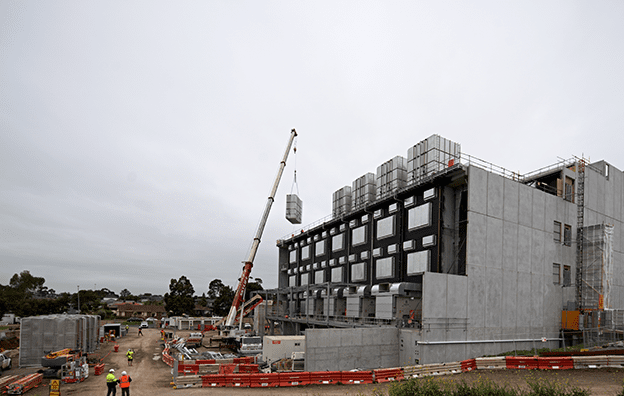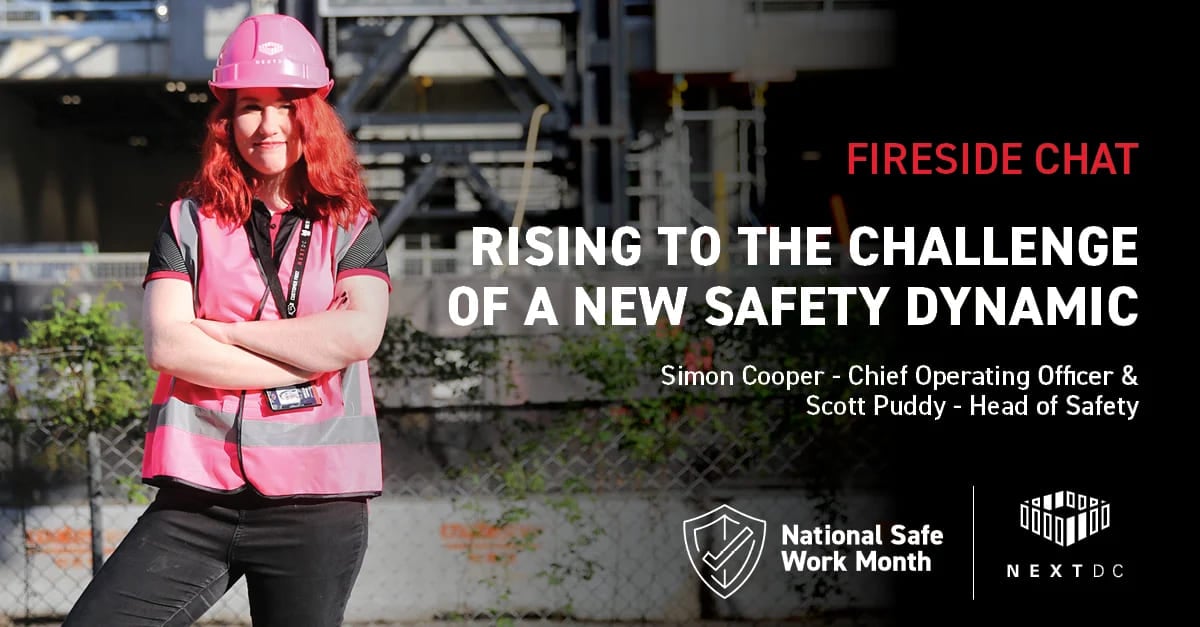Continuing our exploration on safety as a part of National Work Safe Month, we teed up a virtual fireside chat with NEXTDC’s Chief Operations Officer, Simon Cooper and Head of Safety, Scott Puddy to deep dive further into safety. In Part 1 of this conversation, we look at what safety best practice looks like.
What is the big picture overview on why safety is important to NEXTDC?
Simon Cooper, Chief Operations Officer (SC): NEXTDC is really a community, a broad set of employees, partners, contractors, suppliers, customers and other stakeholders. At the end of the day, our number one priority should be, and is, that everyone should go home to their loved ones and enjoy the benefits of their job in the same condition that they arrived, and that means going home safe.
Scott Puddy, Head of Safety (SP): I think it’s an evolving maturity across a lot of different industries. Safety is no longer just seen as a minimum standard, or just words on a wall. A lot of organisations are recognising that employees value the culture of a workplace and a large part of that is how a company approaches health and safety.

We have seen a rising level of focus coming from the top of our organisation, other than the communication, what is NEXTDC doing to ensure safety is our highest priority?
SC: Firstly, we are trying to have safety introduced at the beginning of every conversation. Think of it less as being about pushing it up the agenda stack and more about changing the perspective that in every situation, delivering safety is the first goal. On the supply side for example, rather than leading with price and capability, we should start with safety. Demonstrate to us your safety culture or we are not interested. The second piece is driving much clearer reporting and making that digestible so people can connect what they hear to what they see. Thirdly, changing the mindset from reacting to incidents to preventing them from happening in the first place and learning from both.
SP: Getting safety top-of-mind is key. It’s also getting more sets of eyes helping us through the journey every day. Encouraging more people to start their days thinking about safety first. Gathering a lot more data about near misses and potential hazards allows us to identify common trends across all sites so we can respond before near misses become actual injuries.
What safety certifications are we currently complying to and what plans do we have for the future?
SP: Fundamentally, compliance is a minimum standard for us. What we’re looking at moving to now is the ISO 45001 standard. This recognises that safety culture and expectations are set from the top of an organisation. You have to set big goals up front, and cascade down to team targets. We are looking at how ISO compliance can be streamlined so that ISO 9001 (for quality) and ISO 14001 (environment and sustainability) can be integrated with ISO 45001. Having minimal overlap on these systems will create efficiencies and better performance as the business continues to scale.
So, if compliance with standards is the minimum response, what does best practice around safety look like?
SP: I like to use the three-legged stool analogy; you must have safe environments, safe people, and safe systems or else safety falls over. Our ‘safe environment’ spans the entire lifecycle, from design through construction and onto operations. We have excellent practices in place that are constantly evolving. We learn from our operational facilities where every reported incident or identified hazard is investigated with findings incorporated across the full fleet of data centres and considered for making future generational designs safer. ’Safe people’ refers to how we provide leadership and education to always be risk aware. ‘Safe systems’ refers to having the right processes and risk assessment tools in place plus a cadence for mini assessments, reporting, training, compliance audits etc. Those three elements must all work together to create a great safety culture, but it is a continually moving benchmark.
SC: We are also sharing knowledge with other data centre operators to learn from each other and elevate safety across our industry. If we join the dots then we can make this whole subject front of mind. We also look closely at our supply chains to ensure they place equal emphasis on safety. Safety is an end to end process and that methodical approach needs to be broadened across the entire supply chain. So that everybody is striving for a safer community.
What sort of value will the new Head of Safety role introduce?
SC: It’s a new role the CXO decided it was time to invest in. We are at a point in our maturity cycle, where we are into double figures of data centres under management and considering how to further broaden the reach of NEXTDC beyond Australia. In the past, safety responsibilities were reviewed & reported by Legal and Co Sec based on a shared implementation model, and importantly no individual was well-positioned to take the operating business to the next level. As I mentioned, we are now working at scale with multiple mechanical, construction and electrical risks, so this is an important piece of a safety-led culture.
SP: There is a fabulous culture at NEXTDC. We’re actively seeing our customers and suppliers valuing safety much higher up their priority list, so it’s increasingly important for it to be the first conversation. I am bringing 30 years of health and safety experience with me, and by sharing safety learnings across our suppliers and our customers, we can ensure we continue the safety improvement journey together more effectively and efficiently.
In Part 2 we’ll take a closer look at the unique challenges NEXTDC faces in keeping all of its teams, customers and contractors safe and how a global pandemic introduced a new dynamic to our Pursuit of Excellence in this discipline.


